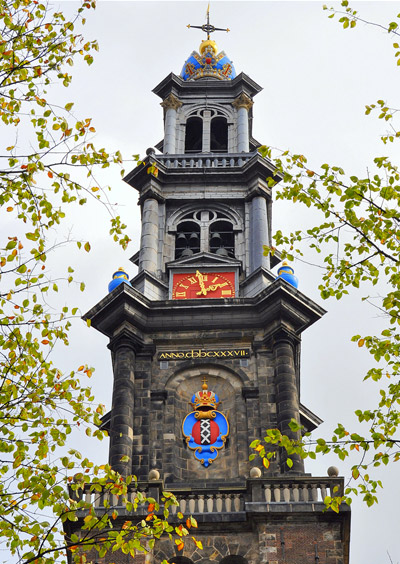Dutch Renaissance style
The Westerkerk was built as a Protestant church on commission of the Amsterdam city council between 1620 and 1631. It was designed and built in Dutch Renaissance style by architect Hendrick de Keyser and his son Pieter de Keyser.
The church - the largest in the Netherlands that was built for Protestants - was given the form of two Greek crosses (a patriarchal cross) connected with each other. It is located on the Prinsengracht, next to Amsterdam's Jordaan district.
Architect Hendrick de Keyser is famous for a number of important buildings which belong to the core of Dutch historic sites. In Amsterdam he built the Oostindisch Huis, Montelbaanstoren, Zuiderkerk, Haarlemmerpoort*, Noorderkerk, Westerkerk, Huis met de Hoofden and Huis Bartolotti.
* Pulled down in 1837 because it had become so dilapidated. The current Haarlemmerpoort was erected 3 years later near the site of the previous one.
Westertoren (Western Tower)
With its 85 meters the Westertoren is the tallest tower in the city. The tower owner is not the church community, but the municipal government. This applied to all 17th-century towers, as they served particulary as observation post for the fire brigade.
Local Amsterdam people call the tower soothingly Ouwe Wester (Old Wester). Its characteristic carillon (set of bells) are made by the Hemony brothers and dates back to 1658. Amsterdam has as much as 4 carillons of the Hemony's, clearly audible from the towers of the Oude Kerk (Old Church), Zuiderkerk (Southern Church), Munttoren and Westerkerk (Western Church).
Imperial Crown
The spire with the imperial crown is from 1638. In 1489, Maximilian I, who was crowned emperor in 1508, gave the city of Amsterdam the right to carry the crown in her coat of arms as a gratitude for the support the city gave him during the Hoekse and Kabeljauwse Twist (Hook and Cod wars), a series of wars and battles in the County of Holland between 1350 and 1490.
Organ
The main organ was completed in 1686. It was built by Duyschot and in 1727 expanded by Vater. In 1992, Flentrop restored the organ as much as possible to its original state.

The paintings on the doors of the organ case are by De Lairesse. On the main doors there are depictions of King David dancing before the Ark of the Covenant and of the Queen of Sheba visiting King Solomon. The smaller doors show music instruments which have become a rarity.
Rembrandt
In 1669 Rembrandt van Rijn was burried here in a rented grave. The exact location of this grave is not known. On the occasion of the 300th anniversary of this birth, in 1906 a commemorative plaque was placed on the northern side of the church, closed to the place where Rembrandt's son Titus was burried.







